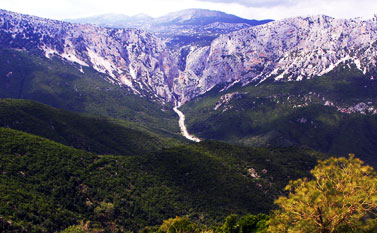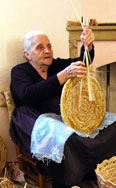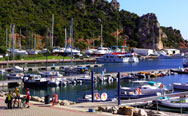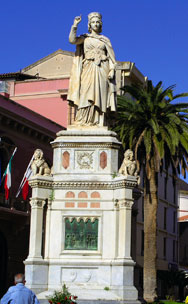- Villa search

- Canaries
- Caribbean
- Croatia, Bulgaria and Hungary
- Cyprus
- Florida
- France and Corsica
- Greece
- Italy
- Lakes and Mountains
- Madeira
- Malta and Gozo
- Portugal
- South Africa
- Spain - Balearics
Picture ColumnInformation

The ‘Grand Canyon’ of Gola Su Gorroppu
‘In the mountains or on the coast, ancient crafts continue to reflect the Sardinian identity, from lacemaking and embroidery to pottery, jewellery, woodcarving or weaving blankets or rugs’
Here Villagrande, there Osini or Ulassai, where vertiginous cliffs challenge free climbers and the Su Marmuri caves claim to be among the best. The snowy peaks of Gennargentu, the ‘Silver Door’ mountains, rise in the distance, reflected in the blue waters of Lake Flumendosa. Horses, cattle and sheep roam freely in pastures carpeted with the pretty flowers of the asphodel.
“Remember Aunty Frederica?” asked Ivan. “This is where she comes to gather rushes.”

Aunty Frederica
We’d met the lady in Santa Maria. At 81, she still weaved traditional baskets made out of dried asphodel plants. She worked the stems dextrously as she had done every day of her life since the age of nine. In the mountains or on the coast, ancient crafts such as this continue to reflect the Sardinian identity, from lacemaking and embroidery to pottery, jewellery, woodcarving or weaving blankets or rugs.
Of course, there’s also the local cuisine: tasty, varied and full of character, just like the islanders. Try culurgiones – homemade ravioli filled with cheesy mash – Sardinian caviar (mullet roe), tender spit-roast wild boar ham and the scrumptious sebadas dessert oozing with honey and melted ewe’s cheese. Add a glass or two of sweet Malvasia or a full-bodied Cannonau and you soon fall in love with all things Sardinian.
Capital in Cagliari

Santa Maria, harbour
After the solitude of the east and the scenic drive south bypassing the popular Costa Rei, Cagliari, the capital, comes as a shock, with its grand palaces, bustling harbour, 21st century entertainment and shopping precincts.
Yet the capital is full of charm with its quaint orange trams snaking along shaded avenues and cosmopolitan crowds sipping fresh orange juice or cappuccinos under the cool arcades of the Via Roma.
There are churches galore, a cathedral with a crypt dug out of the rock and a vast museum complex which could keep you busy for days. The splendid Bastion of San Remy offers unrivalled views over the town and the Gulf of Angels, while just east of the city you’ll find Poetto beach, one of the longest in Italy.
Western delights
The west of the island has its own delights and even the buzzing resort of Alghero will keep you spellbound. Set on the aptly named Coral Riviera, it’s the most Spanish of all Sardinian towns, complete with Catalonian names and architecture. It’s a place to stroll on the battlements past ancient gates and towers, looking out to the dragon-like promontory of Capo Caccia and its famous Neptune cave, an amazing sight if you’re brave – or energetic – enough to tackle the 700 steps down the cliff. Or you could just take the easy option and visit it by boat!

Eleonora d’Arborea on town square
On this stretch of coast, every place is worth a stop: Bosa, Santa Caterina, the hillside village of Cuglieri, the spectacular Gulf of Oristano. Birds of prey circle over the Punic and Roman ruins of Tharros where green salamanders scurry over the hot stones. There’s a lonely chapel dating back to the early days of Christianity and you can look out to the Catalan Rock, the Island of Bad Wind and the red roofs of the provincial capital of Oristano glistening across the bay.
Oristano has its share of attractions, not least February’s spectacular Sa Sartiglia carnival, when masked riders show their prowess on horseback. Most of the time, though, it feels like a village, where its inhabitants are always ready to stop for a break in the piazza or exchange the latest news on the cathedral steps. Council bicycles invite you to explore at a leisurely pace – just pick up a free permit from the town hall.
The town is an important place for Sardinians. In the 14th century, having quelled unrest across much of the island, local ruler and judge Eleonora d’Arborea published the Carta de Logu, a common law constitution which remained in force for 400 years.
Today, on the elegant square bearing her name, a statue of Eleonora stands on a pedestal, smiling over her beautiful island, its rugged mountains and idyllic beaches forever swept by the breeze but as strong as the juniper growing on the slopes of Ogliastra.

Sinis peninsula
Getting there
Ryanair flies daily from London Stansted to Alghero,
Want to know more?
- Sardinia tourism
- Italian State Tourist Board, tel 020 7408 1254
The author
• Solange Hando, e-mail solange.travel@ukonline.co.uk
home | destinations and editorial | villa search | property for sale | car hire | flights | services
villaseek blog | contact villaseek | links and resources | advertise your villa© Dune Root Ltd and Villaseek.com 2012 - Caribbean
- Canaries